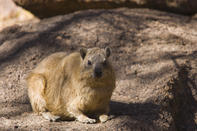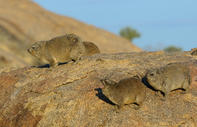Near Ungulates
Dassies, like elephants, are near ungulates. This is the term used to refer to animals that do not have typical hooves like antelope or buffalo (ungulates) but which also do not fit into the carnivore or primate groups (which also have specific foot structures).

Dassies have four stumpy nailed digits on their front feet and three on the hind feet. The soles of their feet are naked and padded to help with traction on the rock faces. Glandular tissue in the feet supplies permanent moisture to the soles, which also improves traction.
Although their limbs are short, dassies are most adept at navigating steep and often slippery surfaces and are agile jumpers. They are also good tree climbers and use their front feet to manipulate vegetation.
Social Life

Dassies live in harems. The males are very territorial and do not tolerate other adult males in their turf whatsoever. The male even drives off his own male offspring when they are just over a year old attacking them with his sharp teeth if they don’t comply.
Each male defends a group of females numbering up to 17 depending on the size of the rocky outcrop and the amount of food available in the area. Under extreme circumstances, dassies are able to travel up to 20 km from their usual retreats to seek food. Usually, it is only the young males ousted from their natal groups that do any travelling. Sometimes older males are also displaced and must seek new residences.
During these travels, they are extremely vulnerable to attack and these young and old individuals are primarily the ones preyed on by black eagles. Dassies have a well-developed vocabulary comprising 21 different vocalizations including growls, grunts, wails, squeals, snorts, whistles, twitters and a sharp bark that warns of danger. Repetitive barking is used to advertise territory. Teeth gnashing is used as a non-vocal form of communication.
By Megan Emmett